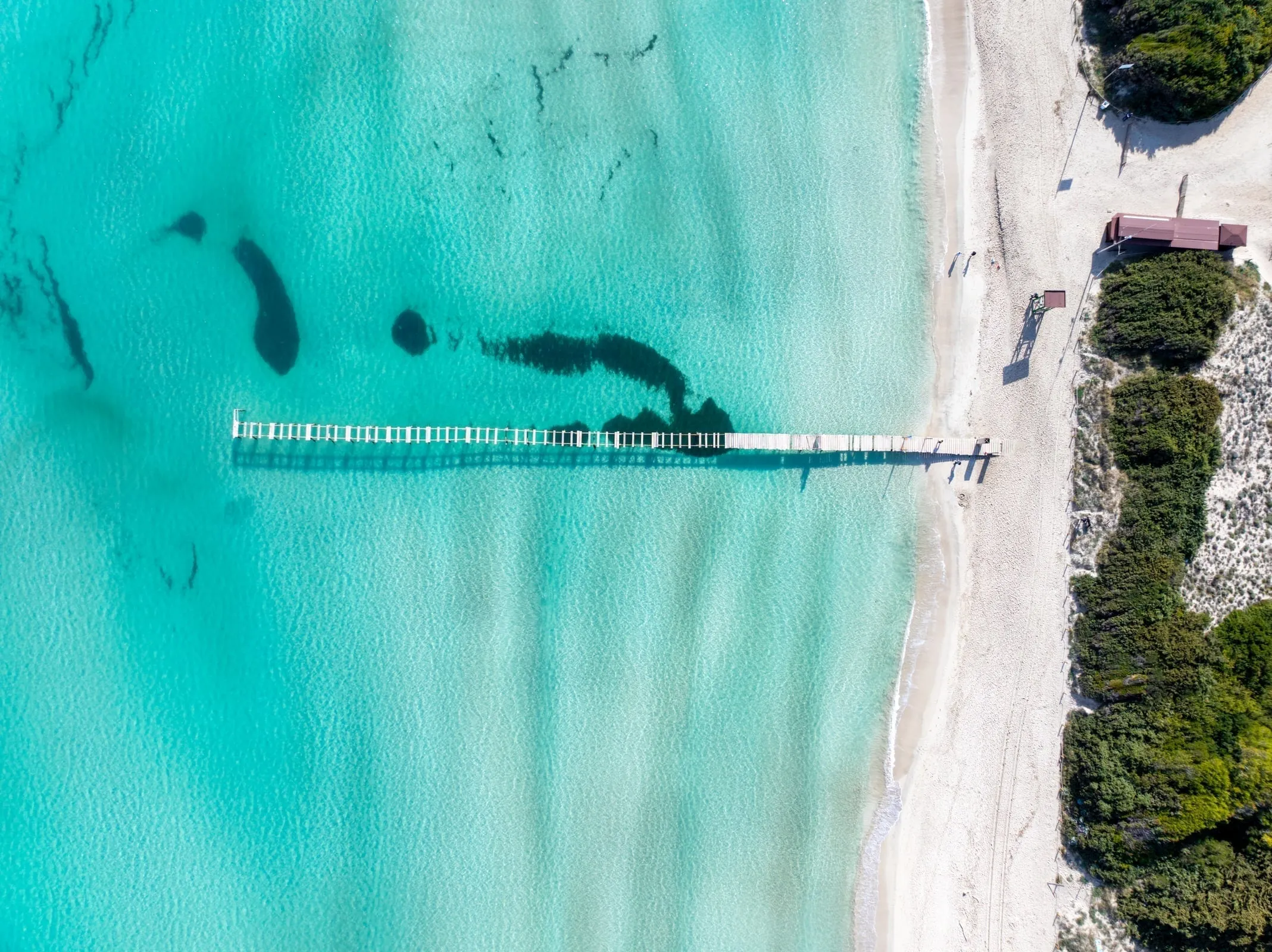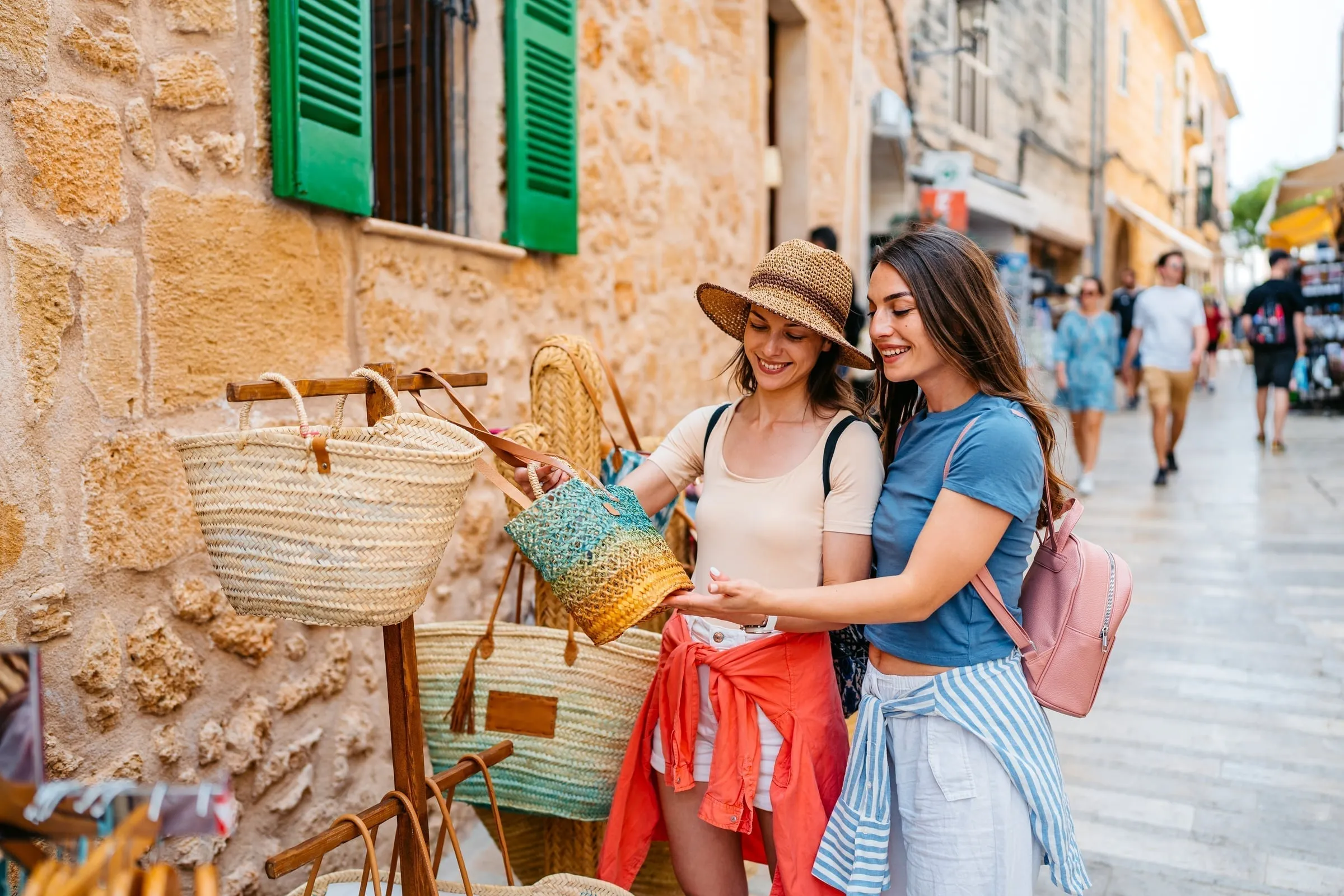
At 6:47am on market Tuesday, vendors arrange tomatoes by size while German retirees queue for the bakery that opens at 7. The medieval walls of Alcúdia, built on Roman foundations that were built on Phoenician stones, catch first light as delivery vans navigate streets designed for donkeys. Three kilometers away at Port d’Alcúdia, beach cleaners rake sand that stretches 7 kilometers to Playa de Muro, preparing for 10,000 daily visitors who choose this engineered paradise over rocky coves.
This is Mallorca’s split personality perfected: a walled medieval town preserving Roman theaters and Renaissance churches, attached by umbilical road to a purpose-built resort where apartment blocks named “Bella Vista” and “Sol y Mar” house half of Germany from May through October. The miracle isn’t that these two Alcúdias coexist – it’s that they need each other, the port funding the old town’s restoration, the old town providing authenticity the port can photograph.
Alcúdia Old Town: Inside the Walls
The Medieval Circuit
The walls encircling Alcúdia stretch 1.5 kilometers, punctuated by 26 towers that once watched for pirates and now watch for parking spaces. Walk the ramparts at sunset (free, always open) starting from Porta del Moll, the seaward gate where medieval merchants paid taxes on goods that made Alcúdia rich before tourism was invented.
The walls tell Alcúdia’s history in stone layers: Roman blocks at the base, medieval additions in the middle, Renaissance refinements on top, modern cement where cars knocked holes. From the walls you see the town’s schizophrenia – terracotta roofs and satellite dishes, Renaissance palaces and German bakeries, church bells and mosque minarets from the immigrant quarter.
Tuesday & Sunday Market Madness
7am-2pm • Year-round

Tuesday market in Alcúdia old town – arrive by 8am for produce, 10am for tourist chaos
Alcúdia’s market transforms the old town into commercial chaos that’s been happening since 1325. The inner ring sells produce where locals pay €1 for tomatoes that cost €3 in Port d’Alcúdia supermarkets. The outer rings hawk leather bags, olive wood, ceramics, and Chinese-made “traditional” crafts to tourists who arrive by bus from hotels.
Market Intelligence:
- 7-9am: Locals shop for produce, meat, cheese
- 9-11am: Tourist buses arrive, prices mentally adjust
- 11am-1pm: Peak chaos, pickpocket prime time
- After 1pm: Vendors discount rather than pack
What’s Worth Buying:
- Olives: €3-5/kg from Petra cooperative
- Sobrassada: €12-14/kg from Sant Joan producers
- Herbs: €2 bundles from mountain villages
- Leather: Only from stalls where they’re actually working leather
- Everything else: Probably from China via Valencia
The Roman Underground
Pollentia Roman Ruins
€4 entry • Tuesday-Sunday 10am-4pm
The Roman city of Pollentia, founded 123 BCE, spreads across fields where Alcúdia grows into suburbia. The site underwhelms until you understand scale – this was Mallorca’s capital for 600 years, controlling trade between Spain and Africa. The theater, seating 2,000, still hosts concerts where you sit on stones where senators debated.
The forum area reveals Roman urban planning: streets on a grid, shops with counters, houses with underfloor heating. The small museum displays everything from surgical tools to dice, proving Romans dealt with hernias and gambling 2,000 years before British package tourists.
Secret Access: The fence behind the theater has a gap where locals enter free after hours. Security cameras exist but nobody monitors them.
Where Old Town Eats
Ca’n Costa
Carrer Sant Vicenç, 14
The Sunday rice restaurant where Alcúdia celebrates baptisms, communions, and divorces. The arroz brut (dirty rice) for €14 feeds two honestly, three if you’re Dutch. Reserve by Thursday or eat elsewhere.
Bistro del Jardín
Carrer Porta Roja, 14
Hidden garden restaurant run by Welsh couple who’ve gone native. Mediterranean-Asian fusion that shouldn’t work but does. The €22 tasting menu changes daily based on market finds. Book the garden table under the lemon tree.
Port d’Alcúdia: The Beach Machine
Understanding the Beach Geography
Port d’Alcúdia’s beach isn’t one beach but a continuous sand system stretching from the marina to Can Picafort. Each section has distinct personality:
Alcúdia Marina to Ciudad Blanca (2km): Narrow beach, shallow water, apartment blocks. German ownership approaches 60%. Beach bars serve schnitzel. Sand imported annually after winter storms.
Ciudad Blanca to Bellevue (2km): Wider beach, package hotels, water sports centers. British sector transitions to German around Hotel Condesa. Jet ski pollution makes swimming unpleasant 10am-6pm.
Bellevue to Playa de Muro (3km): Beach widens to 80 meters. Hotels give way to protected dunes. Nude sunbathing tolerated in pine forests. Best swimming but longest walk from parking.
The Morning Beach Routine
At 6am, the beach belongs to power walkers, their fitbits counting steps on sand groomed by machines that worked through the night. By 7am, German retirees claim loungers they’ll occupy until sunset, €12 paid for all-day shade and status. At 8am, beach restaurants set up, their coffee machines and Eurovision music destroying dawn’s peace.
By 10am, the beach reaches capacity – 40,000 bodies on 7 kilometers of sand, roughly 6 square meters per person if evenly distributed, which they’re not. The sweet spots between beach bars stay empty while crowds cluster around services.
The Water Sports Industrial Complex
Port d’Alcúdia monetizes every water molecule:
- Parasailing: €50 for 10 minutes of terror
- Jet skis: €80/hour to annoy swimmers
- Banana boats: €15 for guaranteed nausea
- SUP rental: €20/hour for Instagram photos
- Sailing lessons: €60/hour to learn knots
- Scuba diving: €65 for pool-like conditions
The diving deserves respect – Alcúdia Bay’s seagrass meadows host seahorses, octopi, and rays. Skualo Diving Center runs marine biology tours where you count species for actual research while pretending you’re on vacation.
S’Albufera Natural Park: The Wetland Escape
The Park That Tourism Forgot
Free entry • Dawn to dusk • 4km from Port d’Alcúdia
S’Albufera, Mallorca’s largest wetland, exists because 1970s environmentalists fought hotel developers and won. The park’s 1,700 hectares of marshes, canals, and dunes host 270 bird species and twelve tourists on average Tuesday.
Enter through the visitor center for free maps and binocular loans (€10 deposit). The 11-kilometer trail network ranges from wheelchair-accessible boardwalks to mud paths requiring boots. The observation towers at dawn deliver flamingos, purple herons, and ospreys fishing in canals dug by British company that tried draining the marsh in 1863.
S’Albufera Intelligence:
- Best months: April-May (migration), September-October (breeding)
- Essential gear: Binoculars, mosquito repellent, water
- Hidden spot: Sa Roca hide, 3km walk, usually empty
- Avoid: Midday heat, weekends, any time after rain (mosquito hell)
The Beach Gate Entrance
Playa de Muro section
The park’s beach entrance, unmarked and unguarded, provides Alcúdia Bay’s only undeveloped shore access. Park at Caseta des Capellans restaurant, walk through pine forest, emerge on beach where no loungers, vendors, or jet skis exist. The swimming requires wading through seagrass, but you’re alone except for kitesurfers who know.
Beyond Tourist Alcúdia
The Immigrant Quarter
Behind Port d’Alcúdia’s hotels, the neighborhoods of Son Fe and Manresa house the workers who clean rooms, serve drinks, and maintain the beach paradise. Moroccan grocery stores sell harissa for €2, Senegalese restaurants serve thieboudienne for €8, Romanian bars show football on fuzzy screens.
This Alcúdia doesn’t appear in brochures, but it’s where kitchen staff live six to an apartment, where wages of €1,200/month try to cover €800 rent, where integration means learning enough German to take restaurant orders.
Victoria Peninsula: The Wild Alternative
The peninsula separating Alcúdia from Pollença Bays offers Mallorca’s easiest wilderness escape. The road to Ermita de la Victoria climbs through pine forest to a hermitage where monks once hid from pirates and now a restaurant serves pilgrim’s menu for €15.
Hiking to Penya Roja
5km round trip • 400m elevation • 2-3 hours
The trail from the hermitage climbs to Talaia d’Alcúdia (444m), the peninsula’s highest point. The path, stepped with stones by unemployment projects in the 1930s, switchbacks through dwarf palms and wild rosemary. The summit’s 360-degree view spans from Cap Formentor to the Artà mountains.
Start at 7am in summer, 10am in winter. Bring water – no sources after the hermitage. The exposure on the final ridge terrifies some; the view compensates.
Bonaire Marina: Where Yachts Sleep
Mallorca’s largest marina holds 1,000 boats from dinghies to superyachts. The public walkway along the moorings provides free entertainment: crews washing boats worth more than houses, owners arguing about mooring fees, charter guests trying to look nautical.
The marina restaurant prices assume yacht ownership, but Bar Miramar at the fishing dock serves the crew meal: fried fish, salad, bread, wine for €12.
Seasonal Realities
Summer (June-September)
Everything open, everywhere crowded. Beach needs 8am arrival for space. Restaurants require reservations. Old town market expands to accommodate tour buses. Heat reaches 38°C. Sea temperature perfect at 27°C.
Shoulder Season (April-May, October)
Germans arrive for cycling and hiking. Beach restaurants reduce hours. Weather variable – swimming possible but not guaranteed. Market maintains size but reduces tourist tat. Hotels offer deals.
Winter (November-March)
Port becomes ghost town. Maybe 20% occupancy. Beach restaurants close. Old town maintains life. Perfect hiking weather. Storms spectacular from harbor walls. Market becomes local again.
Practical Intelligence
Getting Here
From Palma Airport:
- Bus: €8.50, 1.5 hours, hourly
- Taxi: €65-75, 45 minutes
- Rental car: €35/day, parking nightmare in summer
From Palma City:
- Bus: €6.50, 1 hour, every 30 minutes
- Train+Bus: €8 total via Inca, 1.5 hours
Where to Stay
Old Town Alcúdia
Authentic, away from beach
Hotel Can Tem Carrer Llebeig, 6 – Restored mansion, pool in courtyard, breakfast on roof terrace. €110-150/night.
Hostal d’Alcúdia Carrer Hostal, 3 – Basic but central, family-run since 1975. €60/night.
Port d’Alcúdia
Beach access, resort atmosphere
Hotel Astoria Playa Avenida de Francia – Adults-only, beachfront, renovated 2023. €150-250/night.
Aparthotel Ferrer Maristany Carrer Flamencs – Apartments with kitchens, pool, 200m from beach. €100-180/night.
Budget Breakdown
Daily Costs:
- Accommodation: €60-200
- Meals: €20-50
- Beach: Free or €25 (with loungers)
- Transport: €5-15
- Activities: €0-60
Money Savers:
- Shop at old town market
- Beach free if you bring towel
- S’Albufera park free
- Hiking Peninsula Victoria free
- Happy hours 4-7pm
Money Wasters:
- Marina restaurants: Double normal prices
- Beach vendor drinks: €5 for €1 water
- Parasailing: 10 minutes of meh
- Tourist market crafts: Available cheaper online
Navigation Notes
Critical Knowledge
Two Towns: Alcúdia (old town) and Port d’Alcúdia (beach resort) are 3km apart Market Days: Tuesday and Sunday bring traffic chaos Beach Sectors: Germans west, British center, Spanish far east Parking: Nightmare in summer, €5/day at beach lots Language: German more useful than English in port
The Deeper Truth
Alcúdia succeeds because it surrendered strategically. The old town preserved its walls while selling its coast. The port built apartment blocks but protected wetlands. The beach accepts mass tourism but maintains clean sand and clear water.
Watch German retirees who’ve wintered here for 20 years speak Spanish with Mallorcan accents. See British bar owners whose kids attend local schools. Notice how Romanian cleaners become Romanian restaurant owners. Alcúdia absorbs its invaders, turning tourism from occupation into integration.
The secret isn’t choosing between medieval Alcúdia and resort Port d’Alcúdia – they’re symbiotic organs of the same organism. The port generates money, the old town provides soul, the beach delivers product, the mountains offer escape. Together they create Mallorca’s most successful tourist machine, processing millions while maintaining enough authenticity to justify the journey.
Come for seven kilometers of sand and Roman ruins. Stay for the morning when fishing boats return through marina yachts, when market vendors speak four languages while sorting tomatoes, when you realize Alcúdia profits from mass tourism while preserving what matters: walls that survived pirates, wetlands that survived developers, and community that survives everything.
